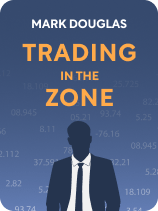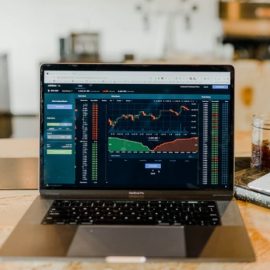

This article is an excerpt from the Shortform book guide to "Trading in the Zone" by Mark Douglas. Shortform has the world's best summaries and analyses of books you should be reading.
Like this article? Sign up for a free trial here .
Why do some people achieve consistent success as financial traders while others fail? Do the successful few have special insider knowledge? Better trading strategies? Astounding good luck?
In his book Trading in the Zone, Mark Douglas says one factor distinguishes successful traders: a winning mindset. To achieve consistent trading success, Douglas says, we need to train ourselves to think differently, and he shows us how.
Below is a brief overview of Trading in the Zone by Mark Douglas.
Market Analysis Strategies and Probabilities
The financial market gives us ample opportunity to generate money. Yet, as Douglas explains, most of us struggle to make the gains we want. The crux of the problem is that we don’t fully understand how the market operates. In this section, we’ll therefore first review the two main strategies traders use to analyze market fluctuations.
As Douglas says, these strategies are useful for predicting which trades are likely to be profitable, but if you rely on them without a solid understanding of probabilities, you may become disillusioned when your predictions don’t come through. If that happens, you’re vulnerable to a fear-based mindset that will sabotage your future success.
After reviewing the two main market analysis strategies, we’ll therefore examine probabilities—the key distinguishing feature of the financial market—so you’re prepared to move past fear, embrace a winning mindset, and use information from your analyses to maximum benefit.
2 Main Strategies for Market Analysis
As Douglas explains in his book Trading in the Zone, discerning patterns in market activity can increase your chances of posting favorable trades. We’ll review the two main types of market analysis that traders commonly use to probe for patterns and discuss why Douglas believes they’re insufficient preparation for consistently successful trades.
Strategy #1: Fundamental Analysis
First, fundamental analysis is a method of assessing the value of an investment using mathematical models. These models take into account multiple variables that could affect the relative balance of supply and demand for that particular investment. Variables include interest rates, competitors, weather patterns, employment rates, and financial statements of the company issuing the stock or bond. By analyzing this data, Douglas says, you may be able to make a plausible forecast of what the price should be at some point in the future. If data suggests a price will rise, you could be wise to invest. But, if data indicates a price will fall, you should likely avoid investing.
According to Douglas, a drawback of this type of analysis is that it doesn’t take into account the potential for other traders to affect prices in an unpredictable way. Traders often make decisions based on emotion, not logic, and this irrational trading activity can dramatically influence prices. For example, traders may panic and sell off stocks in a company based on unfounded rumors that the company’s highly successful CEO is going to resign, thereby causing the price of that company’s stocks to plummet. Thus, fundamental analysis can generate clear and compelling price predictions based on supply and demand factors, but those predictions may nonetheless be grossly inaccurate due to non-rational activity by individual traders.
Strategy #2: Technical Analysis
The second market analysis that’s commonly used is technical analysis. Douglas explains that technical analysis looks at patterns in the price of an investment to predict how that investment’s price is likely to shift in the future. In contrast to fundamental analysis, technical analysis takes into account traders’ activity by attempting to uncover behavioral patterns. Patterns tend to emerge when a group of individuals interacts over time, and these patterns reliably repeat over and over. This allows you to predict the direction prices are likely to move in over set time frames.
As Douglas says, technical analysis is now the favored approach among traders. Whereas fundamental analysis predicts what the market will do based solely on what mathematical models say is logical, technical analysis makes predictions based on how current market activity relates to what’s happened in the past. Therefore, technical analysis is more likely to accommodate nonrational activity that can radically influence prices because it factors in past nonrational events.
Despite the superiority of technical analysis, most traders struggle to translate insights from their analyses into steady profits. Why? Douglas says 95% of trading errors have nothing to do with knowledge. Instead, these errors stem from our fears about losing money, being wrong, or taking profits lower than we could’ve gotten if we’d held onto an investment longer. Therefore, even the most sophisticated technical analysis won’t turn an unsuccessful, frustrated trader into a consistent, confident winner.
(Shortform note: It’s difficult to find data that validates Douglas’s claim that 95% of trading errors stem from traders’ fears. Even the best traders sometimes post losing trades, but it’s impossible to say whether their errors stem from fear or bad information. Whereas Douglas says the way to increase wins is by mitigating the influence of traders’ emotions, others seek to improve knowledge through new technologies such as artificial intelligence (AI) and big data. Both AI and big data can be used to combine and test insights from fundamental and technical analysis as well as information on market sentiment, thereby giving traders an advantage.)
Outcomes Are Always Random
According to Douglas, most of us don’t use information from our market analyses in a sensible way. Why? Because we don’t understand probabilities. Douglas maintains that a knowledge of probabilities is essential to overcome the mental barriers that prevent us from achieving consistent trading success. In this section, we’ll discuss the nuances of probabilities that affect trading by focusing on three main issues: the shallowness of similarities between market trends, why we struggle to understand probabilities, and how we can use probabilities to our advantage.
(Shortform note: Although Douglas asserts that you need to understand probabilities to achieve consistent success, others note that understanding doesn’t necessarily facilitate winning: There’s a difference between knowing and doing. For example, most people know what it takes to improve their level of fitness: eat healthily and exercise. Yet, few people follow through with a consistent fitness regimen. Similarly, you might thoroughly understand probabilities and still make trading decisions that contradict how probabilities work.)
The Shallowness of Similarities Between Market Trends
Market activity is based on probabilities, which means that every outcome is unique and random, totally disconnected from every other outcome. As we’ve already mentioned, patterns do emerge; however, you can’t rely on those patterns to predict outcomes with 100% certainty. As Douglas says, this year’s market activity might appear identical to previous years’ activity, but the similarity doesn’t run any deeper than that.
In reality, says Douglas, this year’s activity stands on its own, distinct from everything prior. Why? Because the combination of traders who generated previous patterns are not the same combination of traders who will generate the next pattern. You’d also have no way to account for a multitude of other variables, including the number of traders planning to enter the market, whether those new entrants will buy or sell, how many shares they’ll want to buy or sell, and whether the traders who are currently involved are planning to exit. Therefore, Douglas asserts, it’s impossible to account for every possible variable.
(Shortform note: Douglas focuses on the potential for individual traders to alter a pattern. However, this isn’t necessarily the full picture—other forces can drastically alter price patterns. For example, an act of terrorism can radically affect stock prices. After the 9/11 terrorist attack in New York, prices plunged more than 11% then rebounded quickly within a month. Other influential forces include inflation, a rise in energy costs, a change in economic policy, and company mergers.)
Although we can never know for sure what’s going to happen next, Douglas says, we often delude ourselves into thinking we can manipulate odds that are out of our control. Imagine this scenario: The price of one stock shows a consistent pattern of rising sharply mid-year after a short springtime slump. You observe this pattern and buy shares of that stock in late spring, anticipating big profits later in the year. But this year, the stock price actually continues to drop throughout the remainder of the year, contrary to your expectations.
When you incur losses like this, Douglas says, you might set out to acquire more and better information, thinking this will put you in a better position to profit in future trades. Or, in an alternative scenario where the stock price does rise as expected and you reap huge rewards, you might become overconfident and reckless in future trades, thinking you’re on a “winning streak.” Both of these tendencies reveal a misunderstanding of how probabilities work. Market activity is random—it’s not subject to manipulation, and it doesn’t play favorites.
Why We Struggle to Understand Probabilities
There’s a reason we have a hard time grasping probabilities. As Douglas explains, our brains aren’t wired to think in terms of probabilities and random outcomes. Rather, we’re programmed to base our decisions on what we’ve experienced in the past, specifically driving us to seek pleasure and avoid pain. For example, if you burn your hand by touching a hot stove, you (hopefully) avoid repeating that same behavior in the future.
But that pain-avoidance/pleasure-seeking programming doesn’t serve your interests when it comes to trading. According to Douglas, more knowledge won’t improve your chances of avoiding the pain of losing, and one wildly profitable trade today doesn’t guarantee you’ll experience the pleasure of winning tomorrow. Remember, probabilities dictate that market outcomes are random, which means they are utterly immune from your efforts and desires to avoid painful losses and experience pleasurable wins.
How We Can Use Probabilities to Our Advantage
Douglas asserts that being a consistently successful trader is simply a matter of conducting a sufficient volume of trades, as your odds of winning improve over a large number of trades (assuming you have a sound strategy). Here’s how this works: Each trade has an edge, which is simply a sign that a price is more likely to move in one direction. Through your market analysis, you can identify a favorable edge, an approach that you think will bring you success and profits. There’s never a guarantee that this edge will turn out to be profitable—as we’ve seen, the randomness of the market means that things can go wrong.
However, if you’ve indeed picked a favorable edge based on market patterns, you can guarantee that you’ll see success consistently over a large period of time. You might not win every time due to the unpredictability of the market, but you’ll win a lot of the time if you stick with it for long enough (and if you have, in fact, picked a profitable edge).
According to Douglas, this is similar to casino operations: even if the house occasionally loses, they know that over time, they’ll eventually win consistently enough to make a profit. This confidence isn’t based on hope, luck, or pure staying power. Rather, casinos impose rules on gamblers that give casinos a roughly 4.5% edge over players. Knowing this, casinos don’t panic each time an individual gambler wins big; they simply keep welcoming players to the games, knowing that the more games people play, the higher the casinos’ profits will be in the end.
The Critical Importance of Embracing Risk
Now that you know why a clear understanding of probabilities—and a steady, long-term approach—is essential to achieve consistent profits and operate from a winning mindset, we need to examine your willingness to embrace risk. According to Douglas, you must embrace risk to ward off irrational fears that corrode your winning mindset and your potential to profit.
In this section, we’ll first examine what embracing risk means, according to Douglas. Then, we’ll look at the factors that cause us to avoid risk and develop an unhealthy relationship with the market: misguided goals and irrational fears. Once you’re clear about the obstacles to relinquishing fear and embracing risk, you’ll be ready to learn and implement the steps Douglas lays out for becoming a consistent trading winner—and putting fear and doubt in your past, which we’ll address in the final section.
What Embracing Risk Really Means
According to Douglas, embracing risk means accepting the possible outcomes of your trades without fear or regret—even negative outcomes. Remember: 95% of trading errors stem from our fears about losing money, being wrong, or selling investments prematurely and therefore missing out on maximum profits. So, to achieve consistent success, you need to be mostly free of fear and related emotions like anger, bitterness, and frustration.
(Shortform note: Although Douglas says we should seek to eliminate fear to trade successfully, others say fear of failure may be helpful in achieving success as a trader. Ray Dalio, founder of Bridgewater & Associates (the world’s largest hedge fund), says he always works out the worst-case scenario in any trade so he can take all appropriate steps to minimize potential loss.)
Misguided Goals and Irrational Fears Cause Us to Avoid Risk
Douglas acknowledges that getting rid of fear can be challenging. After all, the stakes in trading are often very high. Being wrong about a trade and losing money can cause emotional pain and financial ruin. But, Douglas asserts, we need to recognize that our fears are irrational and stem largely from misguided goals that cause us to see the market as a threat. These misguided goals include fulfilling an addiction to intermittent variable rewards, impressing people in our social network, being a savior for our family, and getting a blissful high from winning.
According to Douglas, if we’re motivated by these goals—even just a little—we’ll interpret any market information that indicates we’re wrong as painful. Why? Because by tying our happiness, fulfillment, status, and identity to positive market outcomes, we experience any indication that our goals won’t be fulfilled as a personal threat.
(Shortform note: Is Douglas right that most traders have misguided goals that lead them to see the market as threatening? It’s impossible to know the private goals of all traders. However, research shows that many traders claim to have healthier and more productive goals for investing—everything from compiling savings for retirement, to ensuring the financial security of younger generations, to making donations to charities. Others invest to support businesses they align with ethically. For example, some investors only support businesses with robust environmental initiatives.)
When we perceive the market as a threat, we’re driven by fear to do everything we can to prevent pain (by avoiding risk and losses). We’ll—consciously or unconsciously—second guess our analyses, miss prime buying moments, hesitate to take profits when we should, hold onto losing stocks way too long, and distort or ignore information that goes against our predictions. Meanwhile, Douglas explains, opportunities to cut our losses or make money pass us by. Thus, efforts to avoid risk and pain virtually guarantee failure. Although we might achieve an occasional win, we won’t be consistent winners.
How to Become a Confident, Consistent Winner
Now that you know the obstacles to eliminating fear, embracing risk, and adopting a winning mindset, it’s time to examine how you can overcome those obstacles to become a consistent winner. Douglas says you need three critical ingredients: a clear goal focused exclusively on winning consistently, a system of rules and boundaries for making trades, and disciplined follow-through. Let’s explore each ingredient in detail.
Winning Ingredient #1: A Clear Goal Focused on Winning Consistently
First, Douglas says you need to decide with absolute certainty that what you desire more than anything else when you trade is to win consistently. You have to desire consistency to such an extent that you abandon all other motivations for trading. Once you commit to this singular goal, you’ll willingly accept any outcome the market delivers without emotional distress or fear. Then, you’ll approach market activity not as a way to avoid pain or prove something but as a means to gain an edge and profit.
Douglas says overcoming fear may be faster and easier for some people. Why? People who’ve experienced childhood traumas may have more persistent fear. Also, people may have beliefs that conflict with accumulating wealth, such as the belief that having more money than others is selfish. Nevertheless, Douglas seems to say that everyone—through focused effort—can shift from negative, disempowering beliefs to optimistic, empowering beliefs that form the foundation of a winning mindset.
Entering the “Zone” to Achieve Easy, Effortless Trading
Further, Douglas says, your ultimate goal as a trader should be to achieve consistent success as an automatic, free-flowing expression of who you are. Then, you can experience trading as easy, effortless, fun, and rewarding.
Douglas explains that you can’t force consistency or achieve it through effort. The very act of trying indicates that you’re resisting or struggling against something, or that you’re emotionally attached to getting something from the market. That inclination, though natural, is self-defeating. It ensures that you’ll continue to make fear-based errors.
(Shortform note: While Douglas says effort hinders consistency, many people offer actionable tips for improving trading consistency, implying that you can improve your consistency through effort. For example, trading experts suggest safeguarding your consistency by working to downplay your “herd instinct,” the impulse to follow the crowd and make trading decisions based on what others are doing. The urge to follow the crowd may seem safe, but this reactionary approach can lead to errant and unprofitable trading decisions, thereby sabotaging consistency. Instead, always make sure you base your trading decisions on a coherent strategy, not popular sentiment.)
However, when you’re simply open to whatever the market offers, you can spontaneously enter the “zone.” Douglas describes the zone as a state of mind in which you feel no fear and act intuitively without hesitating. When you’re in this state, your actions always generate a favorable result—without strain or conscious effort. Although Douglas says you can’t intentionally generate a zone mindset, you can set up the conditions for it to spontaneously emerge.
Trading in the zone, Douglas says, is similar to the experience many athletes describe when they spontaneously enter an inherently creative state while performing. While in that state, they perform with astounding proficiency—with an ease and effortlessness that seems almost impossible. They aren’t “trying,” weighing the consequences of their actions, or feeling any fear about messing up. Rather, they’re performing intuitively and seizing opportunities that present themselves moment by moment.
Winning Ingredient #2: A System of Rules and Boundaries for Making Trades
Second, Douglas says you need an organized, systematic set of rules for identifying opportunities to buy or sell. You can purchase a system from an expert, or you can define your rules through fundamental and/or technical analysis. Douglas doesn’t make specific recommendations about a system to use, but he says whichever system you choose must have two specifications:
- Precise variables that you use to make objective decisions—The variables will tell you when you should get into the market, get out of the market, take profits, or cut losses.
- A definitive time frame for analysis—Douglas recommends choosing a consistent time frame on which to base all of the variables you use to identify optimal points of entry and exit. This can be any time frame you want—hours, weeks, months, or years: just keep it consistent.
By creating a precise system, Douglas explains, you’ll eliminate any need to make subjective decisions. You’ll also ensure that no extraneous variables interfere in your analysis.
Winning Ingredient #3: Disciplined Follow-Through
Lastly, Douglas says you need to exercise self-discipline to firmly integrate the beliefs and behaviors that support your goal. You must simultaneously do two things: redirect negative thoughts and emotions, and execute the system you’ve established.
Monitor and Redirect Negative Thoughts
The first part of exercising self-discipline involves closely monitoring your thoughts and emotions. Douglas claims the process of becoming a consistently successful trader is psychological, so you must stay alert to any thought that causes you to doubt your system, yourself, or the market. As we’ve discussed, any time fear surfaces, you become vulnerable to making errors. Therefore, if you detect any fear or negative thoughts, gently redirect your thoughts to the core beliefs that all successful traders internalize, which we’ve already covered:
- Eliminating risk is impossible.
- Each market outcome is unique and random.
- You can never know or control what will happen next.
- You can make money regardless of individual outcomes.
- When you have an edge, every loss brings you closer to a win.
According to Douglas, by routinely redirecting negative thoughts, you can create the mental conditions that allow you to enter the zone. Then, you’ll see market activity as just neutral information, telling you what the odds are for success or failure. In other words, you’ll view the market from a truly objective perspective, seeing it not as a threat but as a source of unlimited opportunities to win and profit. As a result, Douglas says, you won’t be inclined to distort or deny information based on what you’re afraid will happen. Instead, you’ll act without hesitation even in the face of constant uncertainty—with the appropriate amount of restraint.
Execute Over Time
The second part of exercising self-discipline involves perfectly implementing the system you’ve established, resisting any temptation to make adjustments. According to Douglas, by staying disciplined in your thoughts and actions, you’ll accumulate positive experiences that align with your objectives and the beliefs you want, thereby reducing interference from fear, doubt, and negative interpretations of your experiences. Then, you’ll see the market objectively, perceive opportunities clearly, and achieve consistent success. All internal resistance will be gone.
(Shortform note: Can positive experiences offset negative experiences, as Douglas says? Researchers say yes: Studies show that it takes three positive experiences to offset one negative experience. Why do we need more positive experiences to outweigh the effect of a single negative experience? Our brains have a built-in negativity bias that causes us to perceive or overinflate negativity, even when a situation is positive or neutral, and dwell on negative events more than positive ones.)
Thus, if you incur a trading loss, Douglas says your best course of action is to continue trading according to the rules you’ve established in your system (assuming your system is sound). As market activity unfolds, you’re sure to win over the long term due to the probabilistic nature of the market.
Given the dynamic nature of the market, Douglas notes, you’ll likely need to adjust your trading variables and rules at some point. Any edge you define is based only on a single moment in time. As market activity unfolds—and traders come and go—the effectiveness of your system may decline. However, you need to give your current system a chance to work. Remember: You need a large enough sample size for probabilities to play out in your favor.
How many trades are enough to test your variables? Douglas recommends a sample size of at least 20 trades. Then, if needed, you should make adjustments and complete your next 20 trades using the new set of variables. By trading in sample sizes, you’ll be able to accommodate changes while maintaining a steady approach.

———End of Preview———
Like what you just read? Read the rest of the world's best book summary and analysis of Mark Douglas's "Trading in the Zone" at Shortform .
Here's what you'll find in our full Trading in the Zone summary :
- The role mindset plays in stock trading
- The critical importance of embracing risk
- How to become a confident, consistent winner





